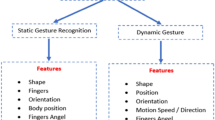Abstract
Lip-reading is one of important approaches for human–computer interaction (HCI). Its development would have a large range of applications, especially in augmented reality. Lip segmentation is the first and foremost step in the lip-reading system. Conventional method of region-based active contour model adopts the global information of image and is unable to perform well. In this paper, from a localized perspective, we introduce the methodology of localized active contour model (LACM) and, meanwhile, propose the method that using LACM to perform the lip segmentation with the initial contour automatically generated. The scope for active contour model is reduced to the local region that reduces the disturbances of unrelated factors. The experimental results demonstrate the method adopts this model would dramatically improve the robustness for lip segmentation. On this basis, we analyze the influence of initial contours and local radiuses, study the efficiencies under different initial contours and compare it with the conventional active contour model which adopts the global information.











Similar content being viewed by others
References
Dupont S, Luettin J (2000) Audio-visual speech modeling for continuous speech recognition. IEEE Trans Multimed 2(3):141–151
Rong C, Yue Z, Jia Y, Wang Y, Yang Y (2012) Research advances in key technology of lip-reading. J Data Acquis Process 27(s2):277–283
Lewis T, Powers D (2002) Lip feature extraction using red exclusion. In: Pan-sydney workshop visualization, pp 61–67
Wang S, Lau W, Leung S, Liew A (2004) Lip segmentation with the presence of beards. Int Conf Acoust Speech Signal Process ICASSP 3:529–532
Leung S, Wang S, Lau W (2004) Lip image segmentation using fuzzy clustering incorporating an elliptic shape function. IEEE Trans Image Process 3(1):51–62
Matthews I, Cootes T, Bangham J, Cox S, Harvey R (2002) Extraction of visual features for lipreading. IEEE Trans Pattern Anal Mach Intell 24(2):198–213
Pardàs M, Sayrol E (2001) Motion estimation based tracking of active contours. Pattern Recognit Lett 22(13):1447–1456
Eveno N, Caplier A, Coulon P-Y (2004) Accurate and quasi-automatic lip tracking. IEEE Trans Circuits Syst Video Technol 14(5):706–715
Liévin M, Delmas P, Coulon PY, Luthon F, Fristol V (1999) Automatic lip tracking: Bayesian segmentation and active contours in a cooperative scheme. In: Proceedings of IEEE international conference multimedia computer systems. Barcelona, Spain, pp 691–696
Liévin M, Luthon F (1999) Unsupervised lip segmentation under natural conditions. In: Proceedings of IEEE international conference acoustics speech signal processing, Phoenix, AZ, USA, pp 3065–3068
Shawn L, Allen T (2008) Localizing region-based active contours. IEEE Trans Image Process 17(11):2029–2039
Liévin M, Luthon F (2004) Nonlinear color space and spatiotemporal MRF for hierarchical segmentation of face features in video. IEEE Trans Image Process 13(1):63–71
Patterson EK, Gurbuz S, Tufekci Z, Gowdy J (2002) CUAVE: a new audio–visual database for multimodal human–computer interface research. In: IEEE international conference on acoustics, speech and signal processing
Srikham M (2012) Active contours segmentation with edge based and local region based. In: 21st international conference on pattern recognition, pp 1989–1992
Mehrotra H, Agrawal G, Srivastava MC (2009) Automatic lip contour tracking and visual character recognition for computerized lip reading. Int J Comput Sci 1:808–817
Leung SH, Wang SL, Lau WH (2004) Lip image segmentation using fuzzy clustering incorporating an elliptic shape function. IEEE Trans Image Process Publ IEEE Signal Process Soc 13(1):51–62
Eveno N, Caplier A, Coulon PY (2001) New color transformation for lips segmentation. In: IEEE fourth workshop on multimedia signal processing, pp 3–8
Acknowledgements
The research was supported by the National Natural Science Foundation of China (61571013) and by the Beijing Natural Science Foundation of China (4143061). The authors thank all the partners and the participants in the experiment for their help.
Author information
Authors and Affiliations
Corresponding author
Ethics declarations
Conflict of interest
The authors declared that they have no conflicts of interest to this work. We declare that we do not have any commercial or associative interest that represents a conflict of interest in connection with the work submitted.
Rights and permissions
About this article
Cite this article
Lu, Y., Zhou, T. Lip segmentation using localized active contour model with automatic initial contour. Neural Comput & Applic 29, 1417–1424 (2018). https://doi.org/10.1007/s00521-017-3046-0
Received:
Accepted:
Published:
Issue Date:
DOI: https://doi.org/10.1007/s00521-017-3046-0




